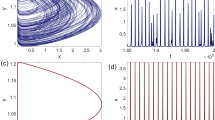Abstract
In either a living system or a non-living system, the interaction among its constituent cells or particles is a fundamental aspect at all scales. For example, during the Bacillus subtilis biofilm formation, cells differentiate into multiple phenotypes to adapt to the environments; few hours after the initial inoculation, we find the phenotype of matrix-producing cells form “chain” structure surrounding the phenotype of the “running” motile cells. We use “chain” to characterize the structure of matrix-producing cells, and “running” to characterize the proliferation and growth of motile cells. Due to a large number of cells in the biofilm, it is impossible to construct a traditional kinetic model to describe the causal link between the single-cell movement and the colony behavior. Here, we obtain cell state information and cell group shape information through experiments; after the image analysis, we get the key interaction rules between cells, and then, we simulate the comparable movement of two cell types and the resulting colony geometry using the multi-agent model. Our work makes a better understanding of the relationship between the macroscopic shape of colonies and microscopic mechanical interactions among cells in the early stage of biofilm growth.









Similar content being viewed by others
References
Ben-Jacob E (2003) Bacterial self-organization: co-enhancement of complexification and adaptability in a dynamic environment. Philos Trans Roy Soc Lond Ser A Math Phys Eng Sci 361(1807):1283–1312
Ben-Jacob E, Garik P (1990) The formation of patterns in non-equilibrium growth. Nature 343(6258):523
Dervaux J, Magniez JC, Libchaber A (2014) On growth and form of Bacillus subtilis biofilms. Interface Focus 4(6):20130051
Flemming H-C, Wingender J (2010) The biofilm matrix. Nat Rev Microbiol 8(9):623
Fu HC, Powers TR, Stocker R (2012) Bacterial rheotaxis. Proc Natl Acad Sci 109(13):4780–4785
Jeckel H, Jelli E, Hartmann R, Singh PK, Mok R, Totz JF, Drescher K (2019) Learning the space-time phase diagram of bacterial swarm expansion. Proc Natl Acad Sci 116(5):1489–1494
Lehn J-M (2002) Toward self-organization and complex matter. Science 295(5564):2400–2403
Liu J, Prindle A, Humphries J, Gabalda-Sagarra M, Asally M, Dong-yeon DL, Süel GM (2015) Metabolic co-dependence gives rise to collective oscillations within biofilms. Nature 523(7562):550
Lopez D, Vlamakis H, Kolter R (2008) Generation of multiple cell types in Bacillus subtilis. FEMS Microbiol Rev 33(1):152–163
Lushi E, Wioland H, Goldstein RE (2014) Fluid flows created by swimming bacteria drive self-organization in confined suspensions. Proc Natl Acad Sci 111(27):9733–9738
Martínez-García R, Nadell CD, Hartmann R, Drescher K, Bonachela JA (2018) Cell adhesion and fluid flow jointly initiate genotype spatial distribution in biofilms. PLoS Comput Biol 14(4):e1006094
Matsuzaki M, Kikura H, Matsushita J, Aritomi M, Akatsuka H (2004) Real-time observation of Brownian motion and cluster movement of ferro-and non-magnetic particles in magnetic fluids. Sci Technol Adv Mater 5(5–6):667–671
Mimura M, Sakaguchi H, Matsushita M (2000) Reaction–diffusion modelling of bacterial colony patterns. Phys A 282(1–2):283–303
Mitchell M (2009) Complexity: a guided tour. Oxford University Press, Oxford
Momeni B (2018) Division of labor: how microbes split their responsibility. Curr Biol 28(12):R697–R699
Olfati-Saber R (2006) Flocking for multi-agent dynamic systems: algorithms and theory. IEEE Trans Autom Control 51(3):401–420
Paton R, Bolouri H, Holcombe WML, Parish JH, Tateson R (2013) Computation in cells and tissues: perspectives and tools of thought. Springer Science and Business Media, Berlin
Reynolds CW (1987) Flocks, herds and schools: a distributed behavioral model, vol 21. ACM, California
van Gestel J, Vlamakis H, Kolter R (2015) From cell differentiation to cell collectives: Bacillus subtilis uses division of labor to migrate. PLoS Biol 13(4):e1002141
Vicsek T, Zafeiris A (2012) Collective motion. Phys Rep 517(3–4):71–140
Vicsek T, Cserző M, Horváth VK (1990) Self-affine growth of bacterial colonies. Phys A 167(2):315–321
Vicsek T, Czirók A, Ben-Jacob E, Cohen I, Shochet O (1995) Novel type of phase transition in a system of self-driven particles. Phys Rev Lett 75(6):1226
Vlamakis H, Aguilar C, Losick R, Kolter R (2008) Control of cell fate by the formation of an architecturally complex bacterial community. Genes Dev 22(7):945–953
Wang X, Meng S, Han J (2017) A continuum theoretical model and finite elements simulation of bacterial flagellar filament phase transition. J Biomech 63:21–31
Wolfram S (2018) Cellular automata and complexity: collected papers. CRC Press, Boca Raton
Acknowledgements
The authors would like to thank Harvard University, US, for their support. The National Natural Science Foundation of China (11772047, 11972074), China, and Key International collaborating project from National Natural Science Foundation of China (11620101001), China.
Author information
Authors and Affiliations
Contributions
In this work, all authors were fully involved in the study and preparation of the manuscript.
Corresponding author
Ethics declarations
Conflict of interest
The authors declare that there is no conflict of interest.
Additional information
Publisher's Note
Springer Nature remains neutral with regard to jurisdictional claims in published maps and institutional affiliations.
Significance statement. In this work, we present a new method to study the growth and evolution of Bacillus subtilis biofilm. The interaction between matrix-producing cell and motile cell in Bacillus subtilis colony is modeled, and the influence of matrix-producing cell on the distribution of motile cell is described by constructing a multi-agent model.
Supplementary Information
Below is the link to the electronic supplementary material.
Supplementary file1 (AVI 1665 KB)
Supplementary file2 (MP4 2234 KB)
Supplementary file3 (MP4 3227 KB)
Supplementary file4 (MP4 2339 KB)
Supplementary file5 (MP4 1862 KB)
Supplementary file6 (AVI 11525 KB)
Rights and permissions
About this article
Cite this article
Hu, S., Wang, X., Tan, Y. et al. ‘Chain and running’ induced by mechanical interactions among cells of different phenotypes in the Bacillus subtilis biofilm. Eur Biophys J 50, 1013–1023 (2021). https://doi.org/10.1007/s00249-021-01562-0
Received:
Revised:
Accepted:
Published:
Issue Date:
DOI: https://doi.org/10.1007/s00249-021-01562-0




